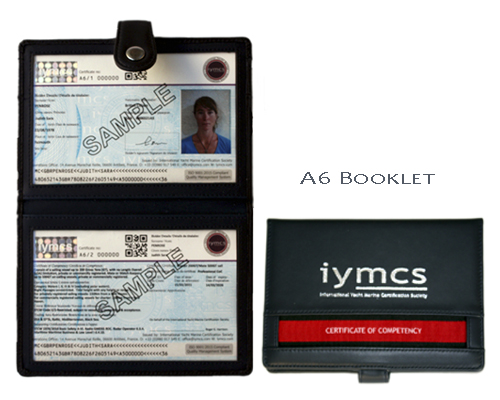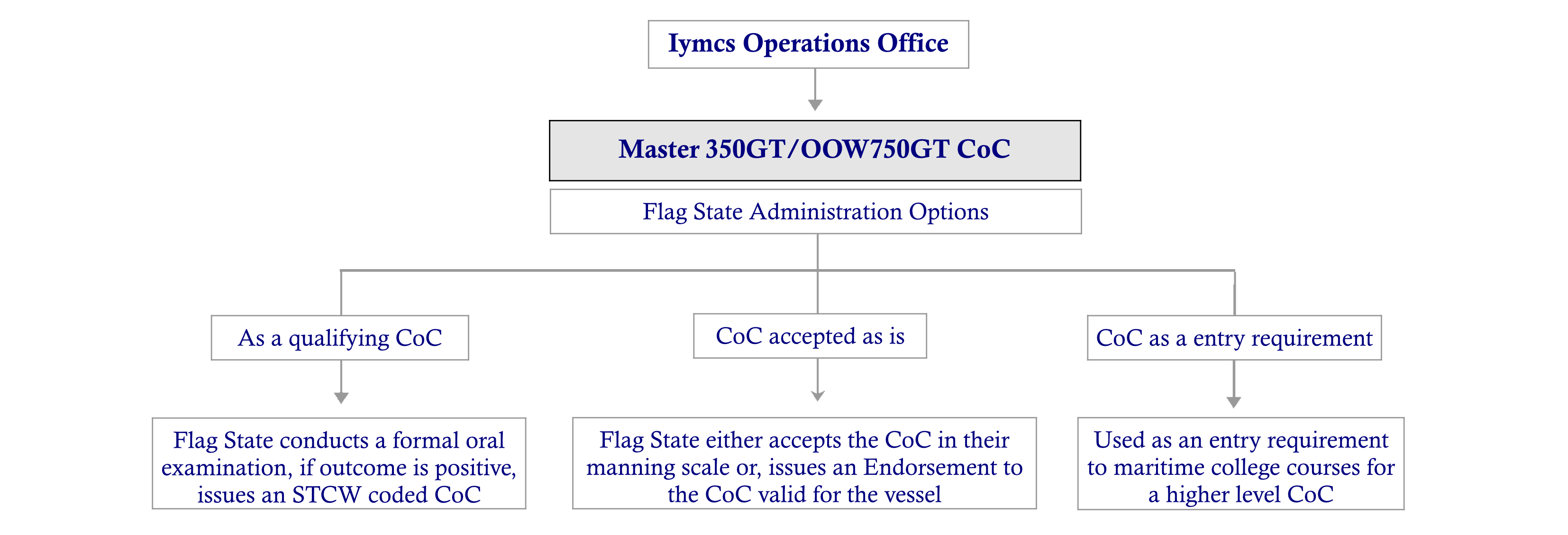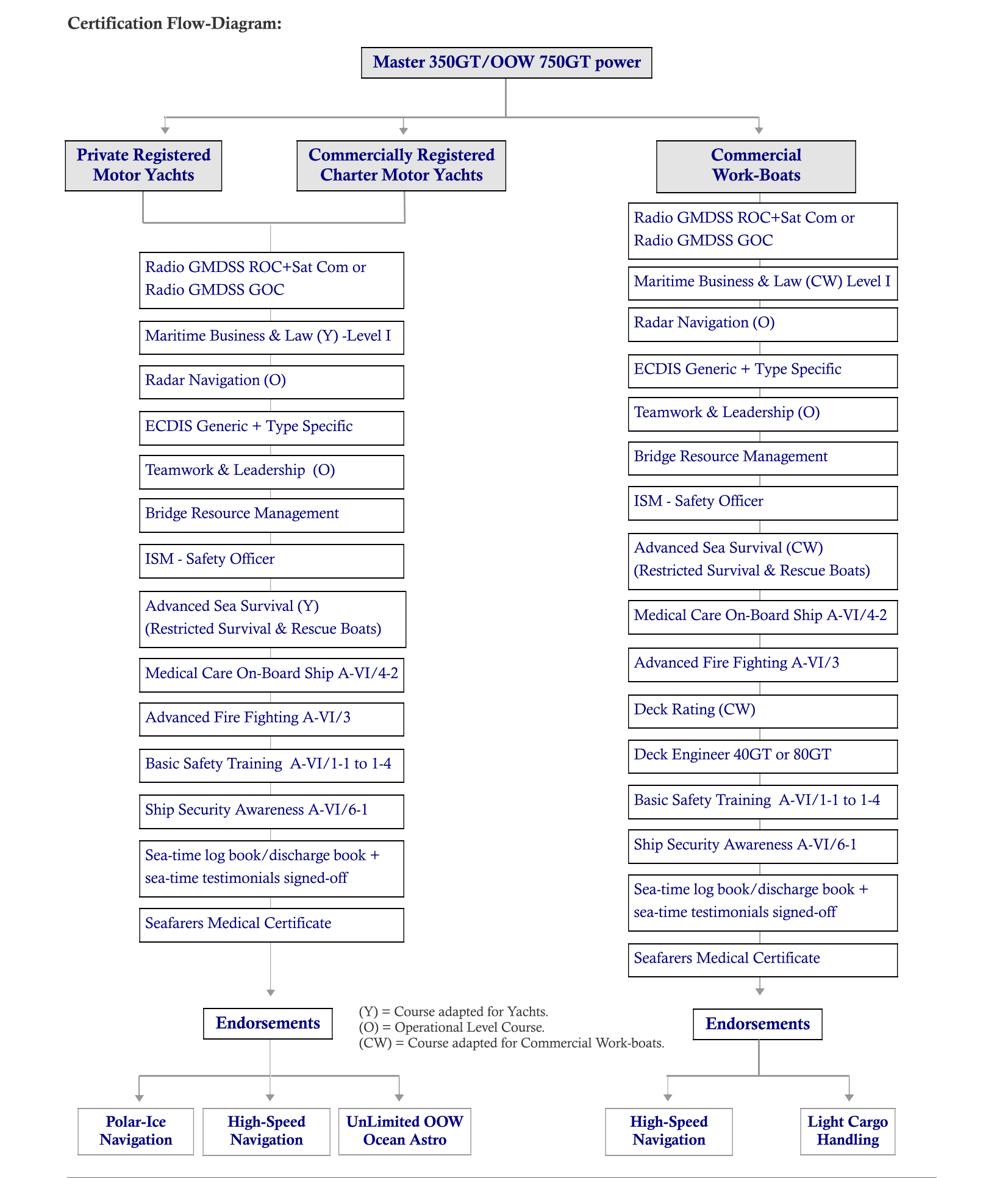
| General Details |
|---|
| Course & Certification:
ID: 6.1.11 Description: Master 350GT/OOW 750GT™ (MY) Certification type: Certificate of Competency ISO 9001:2015 compliance course & certification. |
| Course Length:
A total of 129 hours consisting of; Pre-Course study = 3 hours. |
| Capacity of certification:
1. Captain of a power vessel up to 350 Gross Tons, with no Length Overall (LOA) limitation, private or commercially registered.. 2. Officer of Watch up to 750GT on power vessels, private or commercially registered. 3. Operational limits: For privately registered sailing vessels: 150Nm from a Safe Haven. ** 4. Night passages unrestricted. 5. Tidal area with any height or range. |
| Flag Administration CoC Processes:
When professional crew are applying for a job position on-board a vessel, their certifications are subject to a process of acceptance by the Flag Administration of the vessel. It should be noted that there is no such thing as a globally accepted Certification of Competency. Acceptance of professional CoCs are always on a case-by-case basis. It is very important that any professional CoC adheres as close as possible to the STCW Convention for watch-keeping. As the Iymcs professional Certifications of Competency are restricted in their usage, the Flag Administration may consider the following to undertake: 1. Acceptance of the Iymcs CoC as is for the position on a particular vessel according to their manning scale requirements. 2. Iymcs CoC Endorsed by the Flag for their flagged vessels subject to any restrictions specified by the Flag. 3. Iymcs CoC is used to qualify for a Flag Administration issued STCW Coded CoC possibly subject to an oral examination. 4. Iymcs CoC is used to qualify as an entry qualification for a higher level CoC course(s). |
| STCW Code Adherence:
Adheres to the STCW Code II/2 or II/3 on a case-by case basis subject to Flag acceptance or endorsement or recognition. Trading Area Restrictions: EEA & EFTA, Mediterranean, Baltic, Black Sea. |
| Certification Revalidation:
Yes required every 5 years from the date of issue. |
| Sea-time & Service On-board Requirements:
Sea Areas Category III & IV: 24 months (720 days) service on-board consisting of: OR: Sea Areas Category I & II: 24 months (720 days) service on-board consisting of: |
| Certification issuing requirements:
For Motor Yachts: |

The custom-designed iymcs booklet type certification is stylish and practical.
The booklet outer is made of real leather with a sythentic interior that is resistant to water and protects the certificates.
It is A6 in size, ideal to be kept in a crew document case or with the boat's documents on the bridge.
The Iymcs Certificates are printed to ISO 9001:2015 standards, are dual-language and feature extensive security features
to security level 3 (Government passports & national Iidentification documents are security levels 1 & 2) and can be used as a personal ID in daily situations.
(Nb. It cannot be used instead of a passport/national identity card).
The Iymcs Master 350GT/OOW 750GT™ power course and certification is a restricted Certificate of Competency (CoC) that has been configured to adhere as close as possible to the requirements for watchkeepers under the STCW Codes II/2 or II/3: Thus enabling a clear path to either recognition, acceptance or accreditation on a case-by-case basis by a Flag Administration.
What does a case-by-case basis mean?
When a seafarer applies for a management level position on-board a vessel of any type, as a Captain or Officer of the Watch, the vessel’s flag administration will make
an assessment whether the seafarer is qualified to hold the position. An important aspect to this assessment is the STCW coding of the Certificate of Competency (CoC).
It is only the Flag Administrations that can issue a coded STCW CoC and place them on the STCW Registry at the IMO.
The Iymcs Master 350GT/750GT power is not a coded CoC but is a CoC that adheres closely to the STCW code for watchkeeping: Due to this close adherence, when a holder of the Iymcs CoC is seeking a management position on a vessel i.e. Captain or OOW, the flag administration of that vessel can opt to do one of the following:

The Iymcs Master 350GT/OOW 750GT™ The Master 350GT/OOW 750GT™ power CoC can be configured for either Motor Yachts or Commercial Workboats.
There are several Endorsements that can be added at any time which is a significant advantage for many students or candidates who through future circumstances, may change to other types
of vessels or to operate in other sea areas or oceans.
The Society has defined the CoC capacities as being 150Nm from a Safe Haven for crew working both on privately registered power vessels and commercially registered vessels for charter. This extends the operating radius to 300Nm in total. The operating restriction from Safe Havens can be lifted by undertaking the UnLimited OOW Ocean Astro Course and obtaining the Certificate of Proficiency (CoP).
The comprehensive subject matter covered in the Iymcs Master 350GT/OOW 750GT™ course has a good level of depth of knowledge which gives you a solid grounded knowledge base which is critical for crew wishing to progress to the upper-level certifications such as the Master 500GT. The course is heavily focused upon Safe Working Practises (SWP), Risk Assessments, Watch-keeping requirements, SOLAS, ISM & ISMS etc. Bridge Resource Management is undertaken with a focus upon bridge-team communications.
The diagram below shows the supporting ancilliary courses & certificates, as well as the the Endorsements that are currently available.


Our Society, the 'International Yacht Marine Certification Society" (iymcs) operates its entire operations under a Quality Management System
(QMS) that is in compliance with the International Standards Organisation (ISO) 9001:2015 amended. Part of this compliance involves full auditing procedures.
This is an important reference and enables us to gain recognitions from maritime admininstrations and marine industry bodies alike.
Our Society is ISO 9001:2015 certified by the British Standards Institute (BSI) Netherlands.
The QMS together with the ISO, ensures that Iymcs and its Members operate to the highest standards possible. All our courses, and more importantly the
Certifications that we issue, are under ISO 9001:2015.
This practise is most unusual for such courses and certifications. Some organisations will claim ISO:9001 adherence but often the reality is it is for a document management
process or a similar back-office process instead of for actual operations and/or for Certification issuing.
| Scandinavia 3.100,-EUR | Northern Europe 2.800,-EUR | United Kingdom 2.100,-GBP |
| Southern Europe 2.450,-EUR | Middle East 2.600,-USD | North America 2.800,-USD |
| Prices exclude: course books,certification costs,personal travelling costs,course food and course accommodation. | ||
( Vers. 1.0 ) Click-on '+' to see Syllabus
Nautical terminology. SOLAS general knowledge. ISM - Safe Working Practises. Health & Safety. Risk Assessments. Essential signal flags & morse code. Master’s Standing Orders. Watch-keeping procedures. Introduction to Stability. Principles of the IRPCS. Clean Seas Initiative.
All the Rules 1 to 37 + Annexes I-IV. All sound & light signals. All day-shapes.
Buoyage channel layouts. IALA System A & System B. Major & minor systems. Types of buoyage and marks. Buoyage direction. Safe-water marks. Marina port & harbour entry marks. Beach & landing stages layouts. Buoyage lights -Flash sequences, period of the light, Occulting, Isophase, Morse U & A. Isolated Danger marks. Beacon types.
Morse code & signal flags: A, B, C, D, E, L, M, N, O, Q, U, Z. Standard Marine Communication Phrases (SMCP)
All Vessel types & categories. Steaming lights configuration. Anchor lights. Sailing vessels -configurations. Special purpose vessels lights & signals. Characteristics & positioning of a vessel’s navigation lights.
Admiralty List of Lights. Lighthouses identification, heights and distance off. Beacons, identification by day. Range/Transits, day & night. Sector lights. AIS - beacons & virtual.
Legal requirements to carry charts & publications. Official Log Book. General Navigation Log Book. Bridge Log Book. Deviation table. Pilot books. Tidal Almanacs. Nautical Almanac. Chart and publication updates -Notice to Mariners.
Nautical chart categories. Chart datums. Chart scales. Chart publication check. Reading chart information. Exercises; buoyage & marks identification, depth & obstructions, major lights identification. Chart plotting instruments. Plotting a satellite position from/to ECDIS exercises. Transferring waypoints from/to ECDIS exercises. Measuring distances. Course & bearing measurement. Projected course track.
Basic elements of Meteorology. Barometer & Barograph correctly adjusting & reading. Wet & Dry Bulb thermometer Mid-temperate systems. Tropical & sub-tropical systems. Wind speed & direction. Beaufort Scale & Douglas Scale. Types of depressions. Frontal Depressions. Types of clouds and altitudes. Buys Ballot laws. Coriolis Rules. Sea & Land Breezes. Wave heights and velocity of. Low & high pressure, wind direction. Headland winds. Mountainous coastline wind effects. Meteo Bulletins & Forecasts. Sources of Meteo Information. Marine weather forecasts & synoptic charts Types of fog. Formation & types of; rain, mist & snow. Level of confidence factors of Meteo Forecasts. Navigation or Bridge Log book entries.
Harbour plans. Port entry marks & lights. Buoyage system layout. Depths & obstructions. Different types of TSS. Narrow channels & near-coastal TSS. Approach crossing technique to TSS. Vessel Traffic Systems/Services. Preparation of Pilotage plan/s. Pilot boarding arrangements. Pilot information cards. Pilot & OOW responsibilities.
NOAA & UKHO systems. Tidal height adjustments. Standard tidal curves. One-Quarter/One-Tenth Curve. Table 3. Tidal Streams & Tidal Currents. Top-surface currents. The use of tidal almanacs. Chart Datum concept. Charted depths. Depth contour lines. Drying heights. Calculating time of float-off after grounding. Calculating clearance time to cross a harbour bar. Calculating height clearance under a bridge or cables. Calculating a spot depth for anchoring as close to a shoreline. Sea-bed characteristics. Tidal Diamonds. Tidal Stream Atlases.
Position awareness exercise using plotter with vector charts + local large paper scale chart. Identify land navigation marks and objects. Referencing position to pilot book. Distance off. Positioning using single visual LOP Positioning using Radar VRM or EBL. Two-visual & three-bearing fix. Running fixes (3 types). Port or harbour entry, day & night. Depth control. Heading checks, in-line and by bearing using a pelorous ring. Course to Steer (CTS) calcuations for the steering compasses - gyro, electronic fluxgate & magnetic. Fluxgate autopilot course set-up. Deviation and Variation. Calculation of TVMDC. Analysis of data of; COG, SOG, CTW, STW, DOG, DTW. Pilotage plans. Use of Waypoints. ETA, Speed & Distance calculations. Projected course plot clearing obstructions, shallows & headlands. Fuel consumption planning. Course to Steers to offset leeway and tidal stream & current affects.
Sextant parts, errors & workings. Horizontal Sextant Angles (HSA). Vertical Sextant Angles (VSA)
IAMSAR Manuals Vol 1, 2 & 3. Rescue co-ordination. Search patterns. MedEVAC procedures.
Code of Safe Working Practices for Merchant Seaman (CoSWP). Standing Orders & Work Permits. Precautions to be taken in preparing a vessel for sea. MARPOL regulations: oil, garbage & bunkering. Selection, care and maintenance of wires and ropes of all types. Determining & marking out safe working areas on deck. Crew vessel familiarisation briefings. Crew & guest safety briefings & drills. Preparing the vessel for proceeding to sea.
Principles to be observed in keeping a safe navigational watch. Watch handover procedures. Navigation log book entries. Bridge watch log book. Reporting procedures. Passage planning. Passage monitoring. Responsibilities of the Officer of the Watch in relation to a Pilot on a vessel under pilotage.
Ship design & construction. Yacht design & construction. General Arrangement plans. Chemical & galvanic corrosion. Class Society’s functions. Bilge-pumping arrangements. Mooring arrangements. Anchoring arrangements. Towing arrangements. Bunkering arrangements. Deck scupper arrangements. Steering system arrangements.
Basic principles of hydrostatics and related terms. Free-surface effect. The concept of initial stability. Load lines, reserve buoyancy and methods of damage control.
Speed Log instrument. Depth sounder instrument. Sonar instrument. Gyro compass. Electronic fluxgate compass. Visual bearing sighting rings.
Defining Procedure Cards for the vessel you are on for: Grounding, flooding, fire, sinking, collision, steering system failure, engine failure, power failure; Towing a vessel or to be towed; Fire safety plan; Safety equipment plan.
Diesel engine principles. Propulsion systems. Diesel-Electric system. Hybrid Diesel. Fuel lines & components. Lubricating oil lines & components. Electrical lines & components. Cooling lines & components. Air intakes, lines & components. Thruster units.
Alternators. Generators. Solar panel technology. Battery types & configurations. Electrical circuits & components. Electrical fault finding techniques. IT communication languages. IT hardware & software. IT interfacing circuits & hubs. IT cable & terminal types. IT power supply. IT fault finding techniques.
Hydraulic principles. Hydraulic components, line systems. Hydraulic applications. Hydraulic issues.
MLC 2006 B3.1.7 – Sanitary. Marine toilet types. Macerator pump types. Black or Grey waste water tanks. Black water waste systems. Grey water waste systems. MARPOL sewage regulations.
MLC 2006 B3.1.2 – Ventilation. System & components of: Air ventilation, air conditioning.